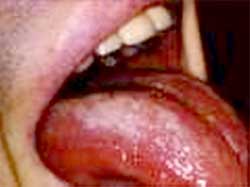Panicillium marneffei infection: An AIDS marker
Penicillium marneffei infection is now considered one of the important indicators of recognition of an HIV-infected person turning into AIDS.
A 29-year-old male patient from Go Dau-Tay Ninh hospital admitted to the Hospital of Tropical Diseases in a fever that lasted for about 30 days. Previously, patients were treated with malaria diagnosis in Go Dau Hospital about 10 days and then returned but the disease did not decrease.
Early death due to fungal infection has not been identified
 A patient with an AIDS infection in the mouth. (Artwork) A few days later, patients admitted to Nguyễn Trãi-TPHCM hospital treated for another 10 days but could not find the cause of the disease.
A patient with an AIDS infection in the mouth. (Artwork) A few days later, patients admitted to Nguyễn Trãi-TPHCM hospital treated for another 10 days but could not find the cause of the disease.
Three days later, the patient was rescued into the Tropical Diseases Hospital in high fever, anemia, exhaustion, liver, spleen and enlarged peripheral lymph nodes. The next day appeared a few scattered marks on the face and penis.
In the blood culture test, patients infected with Penicillium marneffei (PM) were found and HIV positive. Because the medical facilities did not previously identify the disease, the patients were not treated with antifungal therapy from the beginning and died before the results of mushroom culture.
According to the survey, patients had sex with prostitutes in Cambodia 5 years ago.
This is also the first case of PM infection discovered in Vietnam 10 years ago .
PM infection is not only present in AIDS patients but also in normal people. Severe or mild levels of PM infection depend on the body's immunodeficiency. The incidence of infection is particularly high in AIDS patients - those with severe immunodeficiency.
Penicillium marneffei: A sign that HIV infected people turn to AIDS
Up to 96.6% of PM infections are in the AIDS phase. When the patient is in the AIDS phase, the immune system has been severely damaged, this is an opportunity for PM disease to develop. Once infected with PM will affect the immune system making it inherently weakened as it weakens.
In fact, research shows that PM is an indicator of AIDS. Since March 2005, PM's illness has been included in the AIDS diagnosis criteria by the Ministry of Health in Vietnam.

Image of Penicillium marneffei mushroom growing (Photo: medscape)
When infected with PM infection throughout the body, the patient has the usual manifestations of prolonged fever, hepatosplenomegaly, leukopenia, anemia, and prolonged cough, sometimes coughing up blood in the scene of bronchitis, weight loss, weight loss. . Characteristic skin lesions are nodules, concave in the center, sometimes leading to necrosis.
BS.Nguyen The Dung said, the disease caused by the whole body fungus is a dangerous opportunistic infection, if not treated promptly, it will lead to death.
The untreated cases have a bad outcome, the death rate is very high to 91.3% in non-AIDS patients and 100% in AIDS patients.
In the case of treatment, the mortality rate is also quite high, about 20% because when PM penetrates into the body through the respiratory system for some time, it will penetrate into the blood and spread everywhere, causing damage to many organs. Including skin seal. The respiratory tract is the most common route of infection. Treat with antifungal drugs as soon as possible. The initial antifungal agent should be Amphotericin B, which can be combined or replaced with Intraconazole.
Treatment with antifungal agents is very important because common PM infection is common in patients with low CD4 counts and markedly reduced immune function. It is noteworthy that the disease if preventive treatment but not continuous disease will recur or die within 1 year.
So far, Ho Chi Minh City Hospital for Tropical Diseases is the place to discover and treat patients with the highest HIV infection level in the country, by the end of 2003, there were 118 patients. It is noteworthy that nearly half of them did not know that they were infected with HIV when they were admitted to the hospital, so they went to other medical facilities for treatment and treatment with little or no experience so it caused difficulties in treatment. .
Previously, this disease rarely appeared so the experience, knowledge and clinical acumen of doctors to detect the disease is very limited. Resulting in missed or late detection makes treatment difficult. The study is to help doctors treat the disease easily and at the same time have an effective treatment regimen that is the subject of the second major graduation of BS. Nguyen The Dung, Director of HCMC Department of Health.
Nhat Phuong
- There is already an HIV vaccine in normal people
- ARV drugs block HIV / AIDS infection
- Few things know about HIV / AIDS
- Bananas are able to help prevent HIV infection
- AIDS nightmare in Russia
- Prospects gel to help women fight HIV
- Australia claims AIDS is no longer a public health issue
- Cream invention reduces the risk of AIDS infection by 50%
- South Africa: simultaneously circumcised to fight HIV / AIDS!
- Stop testing anti-AIDS gel
- The new vaccine has the ability to prevent HIV / AIDS virus
- The 42-year-old man is cured of AIDS
 Green tea cleans teeth better than mouthwash?
Green tea cleans teeth better than mouthwash? Death kiss: This is why you should not let anyone kiss your baby's lips
Death kiss: This is why you should not let anyone kiss your baby's lips What is salmonellosis?
What is salmonellosis? Caution should be exercised when using aloe vera through eating and drinking
Caution should be exercised when using aloe vera through eating and drinking